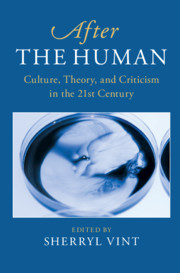Introduction
Published online by Cambridge University Press: 26 November 2020
Summary
This chapter provides an overview of the volume’s purposes and describes why various chapters and critical perspectives have been included in it. It connects the wider project of various ways of thinking “after the human” to the inadequacy of western liberal theoretical perspectives in the face of contemporary challenges: climate change, growing economic inequality, ongoing injustices originating in colonialism and racialization, and espeiallly new developments in science and in STS scholarship that undermines distinctions once made between humans and other organisms, and between organisms and manufactured systems. It explains that the “post” of posthumanism has a range of meanings to different research communities, and argues that it is important that the volume collects perspectives that do not all align with one another, given that dissatifcation with “the human” can be traced, by multiple pathways and to multiple conculsions, to its false claims for universality. Posthumanism, thus, does not label a single new way of thinking about agency and being, but describes a process by which negotiate multiplicity within politics of affinity.
Keywords
- Type
- Chapter
- Information
- After the HumanCulture, Theory and Criticism in the 21st Century, pp. 1 - 12Publisher: Cambridge University PressPrint publication year: 2020

